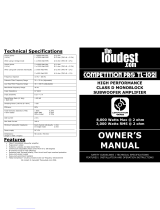
Crossovers
Input Level control
The input level control, 5V – 0,25 V,
matches the output of your radio to
the input of the amplifier. After instal-
lation is complete, make sure the in-
put of the amplifier is turned down all
the way ( counter-clockwise at 5V ).
All DLS Classic amplifiers include high pass filter
( HPF ) and low pass filters ( LPF). On CA23 the
high pass filter is used as a subsonic filter.
All filters are continously variable and all filters can
be switched on and off. CA31 & CA51 also includes
a subsonic filter.
The HPF ( high pass filter ) blocks very low
frequencies from reaching the speakers. It is mostly
used at say 60 Hz to protect small speakers ( like
6 inch and smaller ) from deep bass. It can also be
used as subsonic filter to take away the very
deepest frequencies from a bass box. The typical
setting is then around 25 – 40 Hz. In CA23 the
high pass filter is designed as a subsonic filter
variable from 15 Hz to 150 Hz.
The slope of the High pass filter is 12 dB / octave.
The filter can be switched off if you want to run the
amplifier in full range mode.
High Pass Filter / Subsonic filter
HPF
Off On
50Hz 220Hz
15Hz
500Hz
Low Pass Filter
LPF
Off On
80Hz 200Hz
50Hz
500Hz
The LPF ( low pass filter ) mostly used for
subwoofers. It will allow low frequencies only and
blocks higher frequencies.
A typical setting is 50 – 80 Hz.
The filter can be switched in and out. In the CA23
amplifier you can select between two different
slopes, 12 dB/ octave or 24 dB/ octave.
Choose the slope and the setting that sounds best
in your car.
LPF
Off 24 dB
80Hz 200Hz
50Hz
500Hz
12dB
CA22 CA23
6
CA22 CA23
Subsonic
Off On
40Hz 100Hz
15Hz
150Hz
To ensure best possible performance from the
amplifiers a switch is installed to select between Hi
and Low input.
When using High Level input:
Push in the button to position
”Hi Level”
When using Low level input:
Push out the button to position
”Low Level”
If the switch is set to wrong position, the amplifier
still works, but the risk for disturbances or distortion
increases.
Hi / Low level input switch
CA22, 23, 31, 41 & 51
Hi level
Low level
Play a tape or CD, make sure all bass or treble
settings or equalizer are flat, and turn the volume
of the radio up until you just start to hear distortion.
Turn the volume control down just a bit. On the
amplifier increase the input level control ( clockwise
or to the right ) until you just start to hear distortion,
then back the level control just a bit. Now your ra-
dio and amplifier levels are matched.
Grand bass on CA23 & CA41
Grand Bass is used to increase the bass volume
at an interval of bass frequencies. You can select
the center frequency between 25Hz and 80 Hz
and the amplification between 0 dB ( no
amplification ) and 18 dB ( full amplification ).
The slope of the filter is 10 – 12 dB at maximum
setting.
This function is used to compensate for the bass
box function and to adjust for your own taste of
bass. Set level control at 0 dB if you want it to be
inoperative.
The phase control on CA31 & CA51 can be set
continuously from 0 - 180 degrees. This is very
useful when you want to adjust the bass sound for
best front stage image. Start on 0 and turn the
control slowly clockwise until you experience that
the bass sound is coming from the front. If you dont
get the result you want, also try to
phase reverse the subwoofer
connections and make
a new adjustment.
Phase control CA31 & CA51
0 180
PHASE
Subsonic filter CA31 & CA51
The Subsonic filter blocks the very
deepest frequencies from reaching the
subwoofers. It has a fixed frequency
of 25 Hz and can be switched On / Off.
For sub channels C (CA31) and E
(CA51) only.
Subsonic
Off On
Level
5V
0,25V
Grand Bass
40Hz
60Hz
25Hz 80Hz
0dB 18dB



















